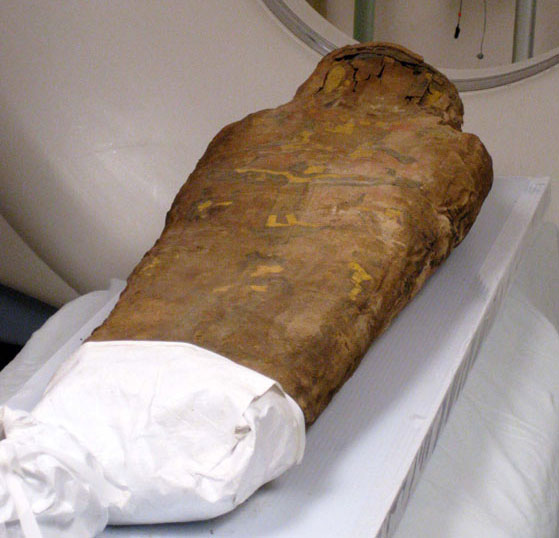Mysterious sex of 2000 year old mummy
In early 2011, a 2,000-year-old mummy was brought to the Illinois state hospital for researchers to use imaging technology to learn about life as well as the cause of death. of this child.
>>>Discover the most mysterious mummies in the world
Conducting CT scans in March 2011 revealed some interesting information: a face with a thin structure, cotton clothes wrapped around the body, the viscera of the body are clearly visible, including both the brain and the bone behind the severely broken head occur after death.
However, this scanning process does not shed light on what the mummy's gender problem is.
"The core part of the gender problem is the pelvis has broken, so anthropologists cannot do traditional measurements on the pelvis to determine its gender, being a boy or a girl." , Sarah Wisseman, an archaeologist conducting the study said.
This is not the first time the mummy was bought from the Spurlock Museum in 1989, which was of interest to the medical community. The mummy is so fragile that it needs to be preserved. Scientists must find a way not to ruin when conducting research on mummies.

Because the pelvis is broken, extracting DNA from the leg bone is not successful
Scientists have not yet determined the sex of this mummy (Photo: Livescience)
After examining the teeth and bones of the mummy, scientists said the mummy was from a child of about 7-9 years old. The mummy was also first scanned at the Carle Foundation Hospital in Urbana, Illinois. Scanning CT using X-ray will reveal the image of bone and soft tissue. This technique allows researchers to reconstruct three-dimensional images of mummies, including internal organs.
After 20 years of research, advances in technology allow researchers to create more high-resolution images and better reproduction, revealing new details, but the big problem - the gender of the body Marinated remains unresolved.
This is a mysterious mummy. Very little information comes with the mummy when it was bought by the museum from a private collector. The mummy was brought to the United States in the 1920s. But no one knows how it was brought and in what region from Egypt to the United States.
In the mummy's packaging, the researchers found a portrait of a male face. Portraits act as an additional identifier for the dead, but, based on previous research on Egyptian mummies, portraits sometimes come not from the dead, Wisseman said.
Comes with the mummy also has images of Egyptian gods painted outside the packaging. Both discovered this image, revealing the time when the mummy was created around 100, in the Egyptian region of the Roman Empire.
The three-dimensional reconstructed mummy face by forensic imaging experts at the National Center for Lost Children found that the child is likely to be a Western Asian or Mediterranean.
The red pigment on the packaging turned out to be lead oxide from Spanish mines. This is similar to the mummy group from Roman times at the Spurlock Museum. It was supposed to be an expensive chemical at the time that proved this child could belong to a wealthy family. Conducting a detailed dental analysis shows that this is a child about 9.5 years old when he dies. But an attempt to extract DNA from a leg bone for research was unsuccessful.
While current technology can only provide certain limited clues about mummies. Hopefully in the future will solve the remaining basics. Members of the research team plan to discuss the new image results on October 2, 2011, at the Spurlock Museum in Urbana, Illinois.
- Close up of 800-year-old
- Discovered a 300-year-old mysterious mummy in China
- The mysterious 2,000-year-old mummy in China still has blood
- The thousand-year-old cat mummy has 5 legs and 3 tails
- New discovery about 2300-year-old Egyptian mummy
- Study 2,500 year mummy of 14-year-old boy
- Close up of the mummy otzi mummy
- 10 mummies contain many mysteries
- Discover the most mysterious mummies in the world
- Revealing the mysterious mummy of men in female attire
- Detected 2,200-year-old mummy with obesity caused by eating a lot of sugar
- Successfully decoded 4,000-year-old mummy thanks to DNA technology
 The truth about the mysterious red-haired giant at Lovelock Cave
The truth about the mysterious red-haired giant at Lovelock Cave Inunaki Tunnel: The haunted road leading into Japan's 'village of death'
Inunaki Tunnel: The haunted road leading into Japan's 'village of death' The mystery of the phenomenon of human reflection before dying
The mystery of the phenomenon of human reflection before dying 6 mysterious phenomena, although science has been developed for a long time, still cannot be answered
6 mysterious phenomena, although science has been developed for a long time, still cannot be answered Accidentally taking a CT scan, an expert discovered the secret of 3 mummies lying inside each other, causing curiosity from 115 years ago
Accidentally taking a CT scan, an expert discovered the secret of 3 mummies lying inside each other, causing curiosity from 115 years ago  Mummy tastes terrible, why would Europeans want to eat it?
Mummy tastes terrible, why would Europeans want to eat it?  Special brown color made from crushed Egyptian mummies
Special brown color made from crushed Egyptian mummies  For the first time, a bandage wound was discovered in an Egyptian mummy
For the first time, a bandage wound was discovered in an Egyptian mummy  Decipher the mystery of how to preserve the fetus in a 2,000-year-old Egyptian mummy
Decipher the mystery of how to preserve the fetus in a 2,000-year-old Egyptian mummy  Discovering a thousand-year-old mummy, archaeologists were stunned with a strange posture, the more they looked, the more scared they became
Discovering a thousand-year-old mummy, archaeologists were stunned with a strange posture, the more they looked, the more scared they became 